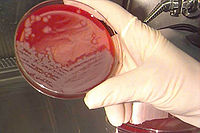- Microbiological culture
-
A microbiological culture, or microbial culture, is a method of multiplying microbial organisms by letting them reproduce in predetermined culture media under controlled laboratory conditions. Microbial cultures are used to determine the type of organism, its abundance in the sample being tested, or both. It is one of the primary diagnostic methods of microbiology and used as a tool to determine the cause of infectious disease by letting the agent multiply in a predetermined medium. For example, a throat culture is taken by scraping the lining of tissue in the back of the throat and blotting the sample into a medium to be able to screen for harmful microorganisms, such as Streptococcus pyogenes, the causative agent of strep throat.[1] Furthermore, the term culture is more generally used informally to refer to "selectively growing" a specific kind of microorganism in the lab.
Microbial cultures are foundational and basic diagnostic methods used extensively as a research tool in molecular biology. It is often essential to isolate a pure culture of microorganisms. A pure (or axenic) culture is a population of cells or multicellular organisms growing in the absence of other species or types. A pure culture may originate from a single cell or single organism, in which case the cells are genetic clones of one another.
For the purpose of gelling the microbial culture, the medium of agarose gel (agar) is used. Agar is a gelatinous substance derived from seaweed. A cheap substitute for agar is guar gum, which can be used for the isolation and maintenance of thermophiles.
Contents
Bacterial culture
Microbiological cultures can be grown in petri dishes of differing sizes that have a thin layer of agar-based growth medium. Once the growth medium in the petri dish is inoculated with the desired bacteria, the plates are incubated at the best temperature for the growing of the selected bacteria (for example usually at 37 degrees Celsius for cultures from humans or animals, or lower for environmental cultures).
Another method of bacterial culture is liquid culture, in which the desired bacteria are suspended in liquid broth, a nutrient medium. These are ideal for preparation of an antimicrobial assay. The experimenter would inoculate liquid broth with bacteria and let it grow overnight (they may use a shaker for uniform growth). Then they would take aliquots of the sample to test for the antimicrobial activity of a specific drug or protein (antimicrobial peptides).
Alternatively, the microbiologist may decide to use static liquid cultures. These cultures are not shaken and they provide the microbes with an oxygen gradient[2].
The main ones being:[3]
Collection Acronym Name Location ATCC American Type Culture Collection Manassas, Virginia NCTC National Collection of Type Cultures Health Protection Agency, United Kingdom BCCM Belgium Coordinated Collection of Microorganism Ghent, Belgium CIP Collection d'Institut Pasteur Paris, France DSMZ Deutsche Sammlung von Mikroorganismen und Zellkulturen Braunschweig, Germany JCM Japan Collection of Microorganisms Saitama, Japan NCCB Netherlands Culture Collection of Bacteria Utrecht, Netherlands NCIMB National Collection of industrial, Marine and food bacteria Aberdeen, Scotland Virus and phage culture
Virus or phage cultures require host cells in which the virus or phage multiply. For bacteriophages, cultures are grown by infecting bacterial cells. The phage can then be isolated from the resulting plaques in a lawn of bacteria on a plate. Virus cultures are obtained from their appropriate eukaryotic host cells.
Eukaryotic cell culture
Isolation of pure cultures
For single-celled eukaryotes, such as yeast, the isolation of pure cultures uses the same techniques as for bacterial cultures. Pure cultures of multicellular organisms are often more easily isolated by simply picking out a single individual to initiate a culture. This is a useful technique for pure culture of fungi, multicellular algae, and small metazoa, for example. m/M;
Developing pure culture techniques is crucial to the observation of the specimen in question. The most common method to isolate individual cells and produce a pure culture is to prepare a streak plate. The streak plate method is a way to physically separate the microbial population, and is done by spreading the inoculate back and forth with an inoculating loop over the solid agar plate. Upon incubation, colonies will arise and, hopefully, single cells will have been isolated from the biomass.
References
- ^ http://www.webmd.com/a-to-z-guides/throat-culture
- ^ Old, D.C.; Duguid, J.P. (1970). "Selective Outgrowth of Fimbriate Bacteria in Static Liquid Medium". Journal of Bacteriology (American Society for Microbiology) 103 (2): 447–456. PMID 248102.
- ^ Madigan, Michael (2009). Brock Biology of Microorganisms. San Francisco: Pearson/Benjamin Cummings. ISBN 0132324601.
External links
- [1], www.effca.org - European Food and Feed Cultutes Association - EFFCA. Information about production and uses of microbial cultures as well as legislative aspects.
See also
- Blood culture
- Sputum culture
- Screening cultures
- Synchronous culture
- NCPPB
- ICMP
- DSMZ
Categories:- Microbiology techniques
- Microbiology terms
- Cell cultures
Wikimedia Foundation. 2010.

